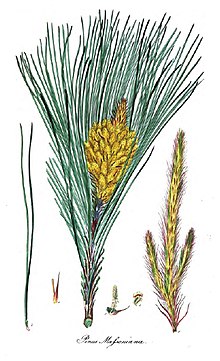Pinus massoniana
| Masson's pine | |
|---|---|

| |
| Scientific classification | |
| Kingdom: | Plantae |
| Clade: | Tracheophytes |
| Clade: | Gymnospermae |
| Division: | Pinophyta |
| Class: | Pinopsida |
| Order: | Pinales |
| Family: | Pinaceae |
| Genus: | Pinus |
| Subgenus: | P.subg.Pinus |
| Section: | P.sect.Pinus |
| Subsection: | P.subsect.Pinus |
| Species: | P. massoniana
|
| Binomial name | |
| Pinus massoniana | |
Pinus massoniana(English:Masson's pine,Chinese red pine,horsetail pine;Chinese: Mã vĩ tùng ) is a species ofpine,native to Taiwan, a wide area of central and southern China, and northern Vietnam.
Description
[edit]
It is anevergreentree reaching 25–45 metres (82–148 feet) in height, with a broad, rounded crown of long branches. Thebarkis thick, grayish-brown, and scaly plated at the base of the trunk, and orange-red, thin, and flaking higher on the trunk. Theleavesare needle-like, dark green, with two per fascicle,12–20 centimetres (4+1⁄2–8 inches) long and0.8–1 millimetre (1⁄32–3⁄64in) wide, the persistent fascicle sheath1.5–2 cm (5⁄8–3⁄4in) long. Theconesare ovoid,4–7 cm (1+5⁄8–2+3⁄4in) long, chestnut-brown, opening when mature in late winter to4–6 cm (1+5⁄8–2+3⁄8in) broad. Theseedsare winged,4–6 mm (5⁄32–1⁄4in) long with a10–15 mm (3⁄8–9⁄16in) wing. Pollination occurs in mid-spring, with the cones maturing 18–20 months after.[2][3][4]
Distribution and habitat
[edit]It is native to Taiwan, a wide area of central and southern China including Hong Kong, and northern Vietnam, growing at low to moderate altitudes, mostly below 1,500 m (4,900 ft) but rarely up to 2,000 m (6,600 ft) above sea level.[5]
Ecology
[edit]In the 1970s and 80s, thePinewood nematodefrom North America andpine-needle scale insectfrom Taiwan, together virtually eliminated the nativePinus massonianain Hong Kong.[6]
Fossil record
[edit]Afossilseed cone and several needles ofPinus massonianahave been described from theupper MioceneWenshan flora,Yunnan,SW China.The fossils most resemble thevarietyP. massoniana var. hainanensis,which is a tropical montanethermophilictree restricted toHainan Islandin southern China.[7]
Uses
[edit]The species is a common tree used inplantationforestryfor replacing or compensating for the loss of the natural forest in southern China.[8]Chineserosinis obtained mainly from theturpentineofP. massonianaandslash pine(P. elliottii).
Logs are mainly used to make pulp forpaper industry.
Leaves are used to give special smoke flavor to a localblack tea,such asLapsang souchongofFujian.
Habit
[edit]Notes
[edit]- ^Farjon, A. (2013)."Pinus massoniana".IUCN Red List of Threatened Species.2013:e.T42379A2976356.doi:10.2305/IUCN.UK.2013-1.RLTS.T42379A2976356.en.
- ^Farjon, A. (2005).Pines,ed. 2. Brill, Leiden.ISBN90-04-13916-8.
- ^Richardson, D. M. (1998).Ecology and Biogeography of Pinus.Cambridge.ISBN0-521-55176-5.
- ^Gymnosperm Database:Pinus massoniana
- ^Mirov, N. T. (1967).The Genus Pinus.Ronald Press.
- ^Porcupine! 23 - Hong Kong's Bad Biodiversity
- ^The occurrence of Pinus massoniana Lambert (Pinaceae) from the upper Miocene of Yunnan, SW China and its implications for paleogeography and paleoclimate by Jian-Wei Zhang, Ashalata D'Rozario, Jonathan M. Adams, Xiao-Qing Liang, Frédéric M.B. Jacquesa, Tao Su and Zhe-Kun Zhoua, Review of Palaeobotany and Palynology Volume 215, April 2015, Pages 57-67
- ^Ecosystem services of various types of artificial forest in South China – a provisional summary
References
[edit]- Farjon, A. (2013)."Pinus massoniana".IUCN Red List of Threatened Species.2013:e.T42379A2976356.doi:10.2305/IUCN.UK.2013-1.RLTS.T42379A2976356.en.
- Pinus massoniana - Plants For A Future database report
- eFloras, Missouri Botanical Garden & Harvard University Herbaria,Pinus massoniana,vol. 4, p. 14,retrieved23 October2009




